technical data SKODA OCTAVIA 2014 3.G / (5E) Owner's Manual
[x] Cancel search | Manufacturer: SKODA, Model Year: 2014, Model line: OCTAVIA, Model: SKODA OCTAVIA 2014 3.G / (5E)Pages: 280, PDF Size: 35.53 MB
Page 4 of 280
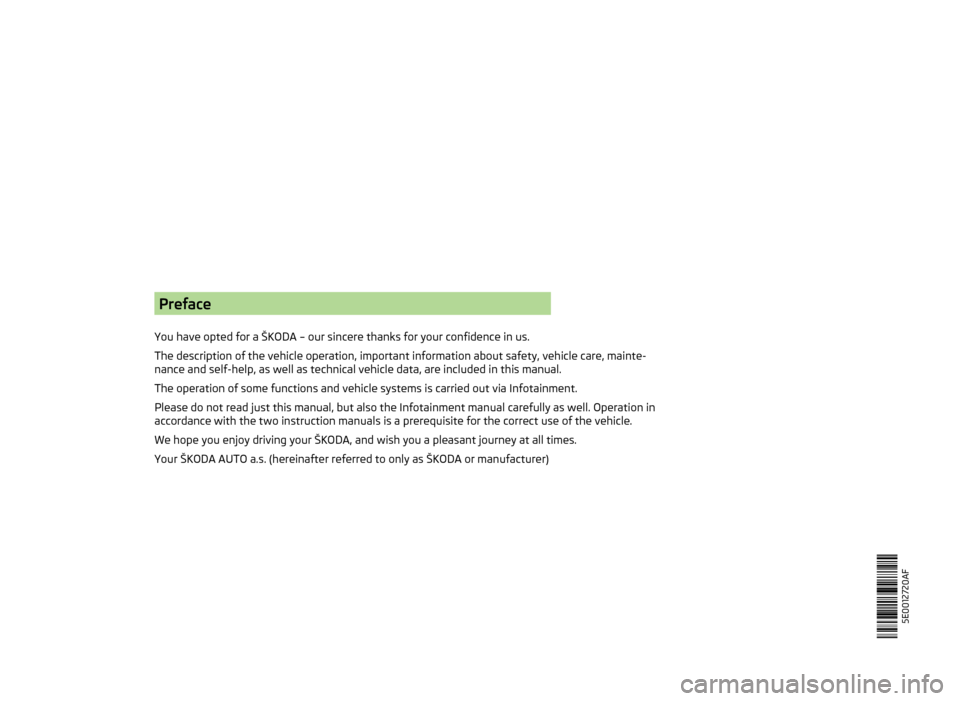
Preface
You have opted for a ŠKODA – our sincere thanks for your confidence in us.
The description of the vehicle operation, important information about safety, vehicle care, mainte-
nance and self-help, as well as technical vehicle data, are included in this manual.
The operation of some functions and vehicle systems is carried out via Infotainment.
Please do not read just this manual, but also the Infotainment manual carefully as well. Operation in
accordance with the two instruction manuals is a prerequisite for the correct use of the vehicle.
We hope you enjoy driving your ŠKODA, and wish you a pleasant journey at all times.
Your ŠKODA AUTO a.s. (hereinafter referred to only as ŠKODA or manufacturer) 5E0012720AF
Page 6 of 280
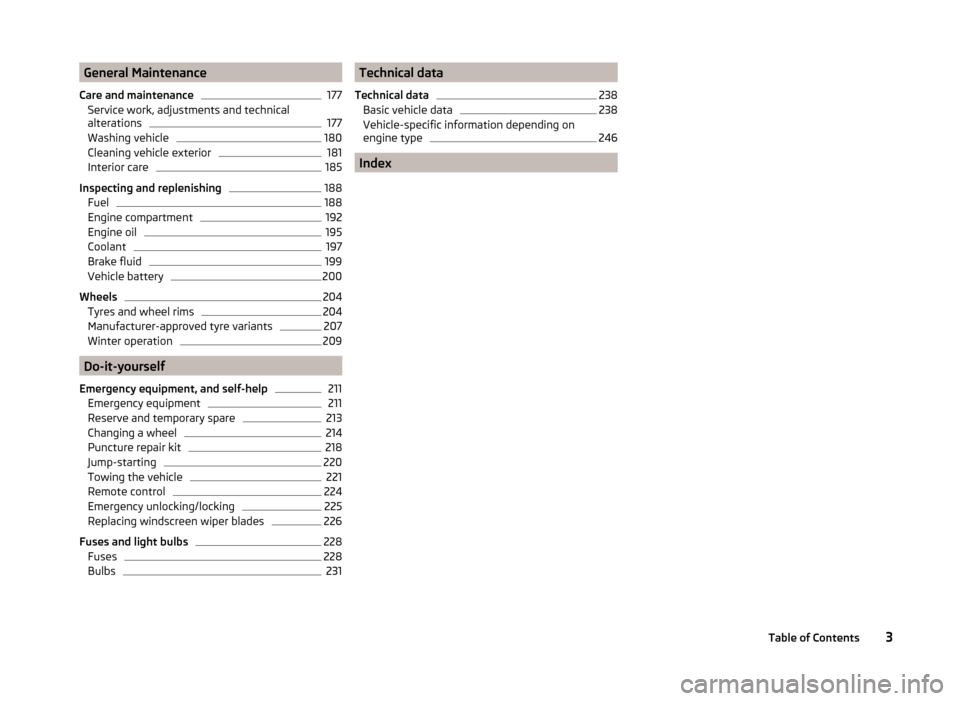
General Maintenance
Care and maintenance177
Service work, adjustments and technical alterations
177
Washing vehicle
180
Cleaning vehicle exterior
181
Interior care
185
Inspecting and replenishing
188
Fuel
188
Engine compartment
192
Engine oil
195
Coolant
197
Brake fluid
199
Vehicle battery
200
Wheels
204
Tyres and wheel rims
204
Manufacturer-approved tyre variants
207
Winter operation
209
Do-it-yourself
Emergency equipment, and self-help
211
Emergency equipment
211
Reserve and temporary spare
213
Changing a wheel
214
Puncture repair kit
218
Jump-starting
220
Towing the vehicle
221
Remote control
224
Emergency unlocking/locking
225
Replacing windscreen wiper blades
226
Fuses and light bulbs
228
Fuses
228
Bulbs
231Technical data
Technical data238
Basic vehicle data
238
Vehicle-specific information depending on
engine type
246
Index
3Table of Contents
Page 7 of 280
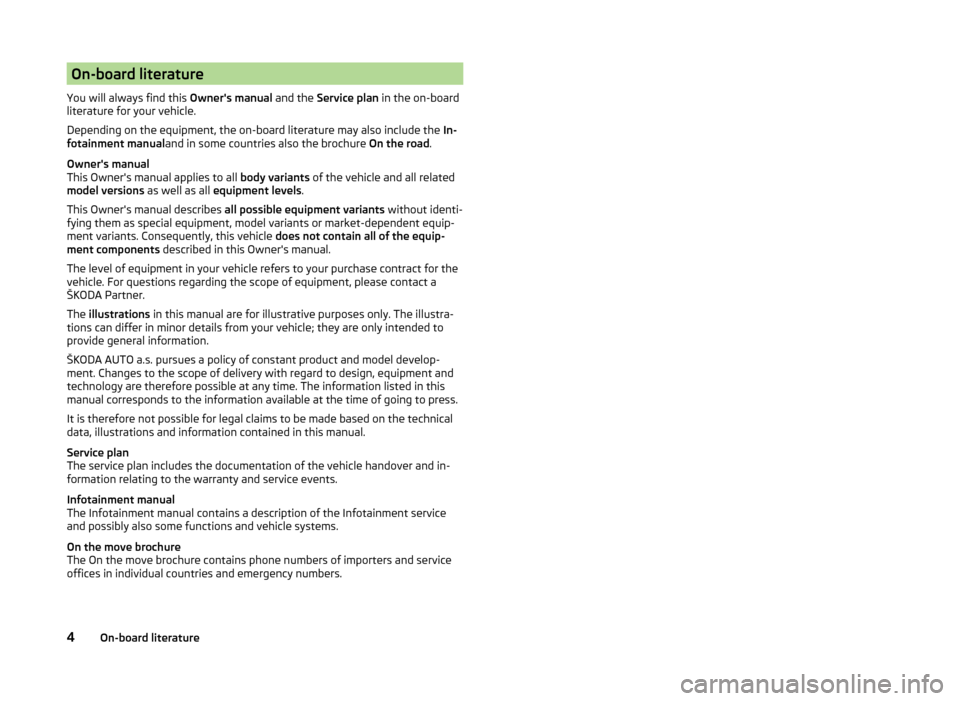
On-board literature
You will always find this Owner's manual and the Service plan in the on-board
literature for your vehicle.
Depending on the equipment, the on-board literature may also include the In-
fotainment manual and in some countries also the brochure On the road.
Owner's manual
This Owner's manual applies to all body variants of the vehicle and all related
model versions as well as all equipment levels .
This Owner's manual describes all possible equipment variants without identi-
fying them as special equipment, model variants or market-dependent equip-
ment variants. Consequently, this vehicle does not contain all of the equip-
ment components described in this Owner's manual.
The level of equipment in your vehicle refers to your purchase contract for the
vehicle. For questions regarding the scope of equipment, please contact a
ŠKODA Partner.
The illustrations in this manual are for illustrative purposes only. The illustra-
tions can differ in minor details from your vehicle; they are only intended to
provide general information.
ŠKODA AUTO a.s. pursues a policy of constant product and model develop-
ment. Changes to the scope of delivery with regard to design, equipment and
technology are therefore possible at any time. The information listed in this
manual corresponds to the information available at the time of going to press.
It is therefore not possible for legal claims to be made based on the technical
data, illustrations and information contained in this manual.
Service plan
The service plan includes the documentation of the vehicle handover and in-
formation relating to the warranty and service events.
Infotainment manual
The Infotainment manual contains a description of the Infotainment service
and possibly also some functions and vehicle systems.
On the move brochure
The On the move brochure contains phone numbers of importers and service
offices in individual countries and emergency numbers.4On-board literature
Page 140 of 280
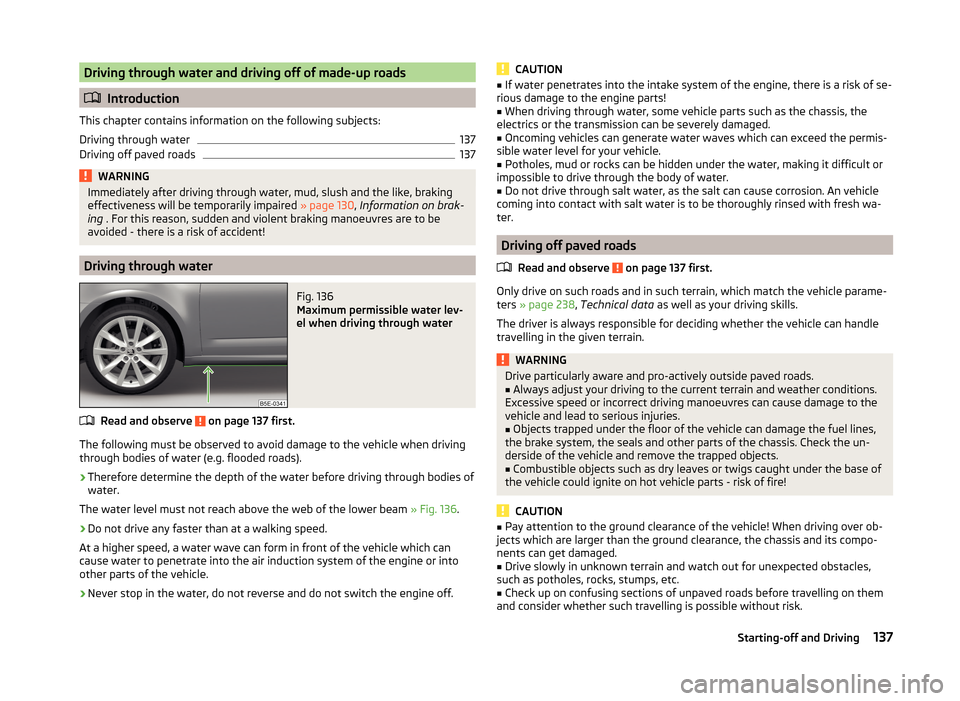
Driving through water and driving off of made-up roads
Introduction
This chapter contains information on the following subjects:
Driving through water
137
Driving off paved roads
137WARNINGImmediately after driving through water, mud, slush and the like, braking
effectiveness will be temporarily impaired » page 130, Information on brak-
ing . For this reason, sudden and violent braking manoeuvres are to be
avoided - there is a risk of accident!
Driving through water
Fig. 136
Maximum permissible water lev-
el when driving through water
Read and observe on page 137 first.
The following must be observed to avoid damage to the vehicle when driving through bodies of water (e.g. flooded roads).
›
Therefore determine the depth of the water before driving through bodies of
water.
The water level must not reach above the web of the lower beam » Fig. 136.
›
Do not drive any faster than at a walking speed.
At a higher speed, a water wave can form in front of the vehicle which can
cause water to penetrate into the air induction system of the engine or into
other parts of the vehicle.
›
Never stop in the water, do not reverse and do not switch the engine off.
CAUTION■ If water penetrates into the intake system of the engine, there is a risk of se-
rious damage to the engine parts!■
When driving through water, some vehicle parts such as the chassis, the
electrics or the transmission can be severely damaged.
■
Oncoming vehicles can generate water waves which can exceed the permis-
sible water level for your vehicle.
■
Potholes, mud or rocks can be hidden under the water, making it difficult or
impossible to drive through the body of water.
■
Do not drive through salt water, as the salt can cause corrosion. An vehicle
coming into contact with salt water is to be thoroughly rinsed with fresh wa-
ter.
Driving off paved roads
Read and observe
on page 137 first.
Only drive on such roads and in such terrain, which match the vehicle parame-ters » page 238 , Technical data as well as your driving skills.
The driver is always responsible for deciding whether the vehicle can handle
travelling in the given terrain.
WARNINGDrive particularly aware and pro-actively outside paved roads.■Always adjust your driving to the current terrain and weather conditions.
Excessive speed or incorrect driving manoeuvres can cause damage to the
vehicle and lead to serious injuries.■
Objects trapped under the floor of the vehicle can damage the fuel lines,
the brake system, the seals and other parts of the chassis. Check the un-
derside of the vehicle and remove the trapped objects.
■
Combustible objects such as dry leaves or twigs caught under the base of
the vehicle could ignite on hot vehicle parts - risk of fire!
CAUTION
■ Pay attention to the ground clearance of the vehicle! When driving over ob-
jects which are larger than the ground clearance, the chassis and its compo-
nents can get damaged.■
Drive slowly in unknown terrain and watch out for unexpected obstacles,
such as potholes, rocks, stumps, etc.
■
Check up on confusing sections of unpaved roads before travelling on them
and consider whether such travelling is possible without risk.
137Starting-off and Driving
Page 178 of 280
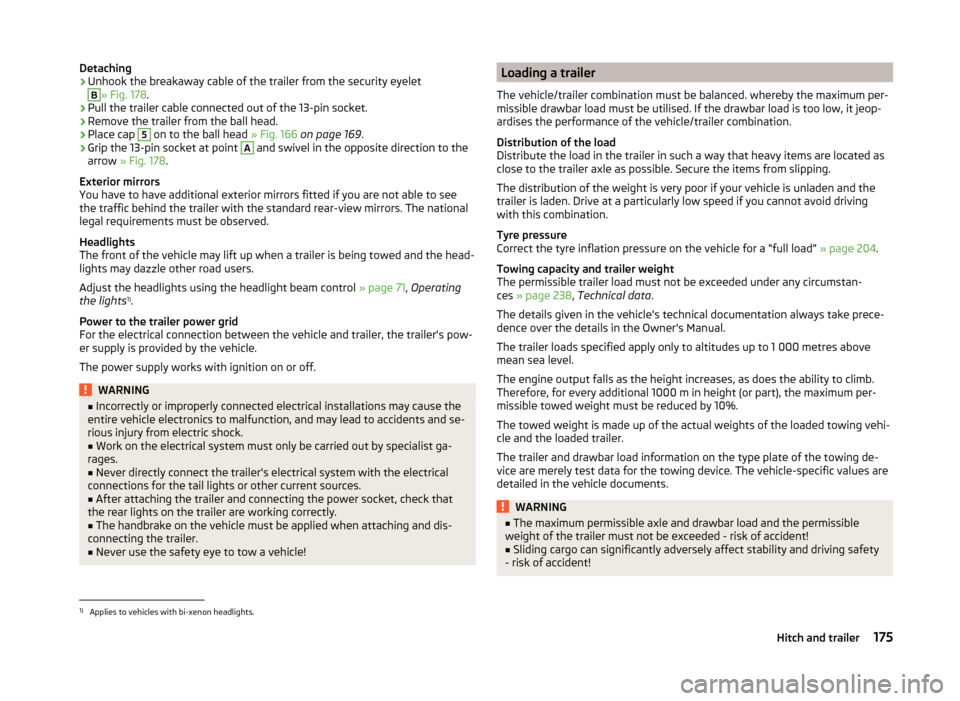
Detaching›Unhook the breakaway cable of the trailer from the security eyeletB
» Fig. 178.
›
Pull the trailer cable connected out of the 13-pin socket.
›
Remove the trailer from the ball head.
›
Place cap
5
on to the ball head » Fig. 166 on page 169 .
›
Grip the 13-pin socket at point
A
and swivel in the opposite direction to the
arrow » Fig. 178 .
Exterior mirrors
You have to have additional exterior mirrors fitted if you are not able to see
the traffic behind the trailer with the standard rear-view mirrors. The national
legal requirements must be observed.
Headlights
The front of the vehicle may lift up when a trailer is being towed and the head-
lights may dazzle other road users.
Adjust the headlights using the headlight beam control » page 71, Operating
the lights 1)
.
Power to the trailer power grid
For the electrical connection between the vehicle and trailer, the trailer's pow-
er supply is provided by the vehicle.
The power supply works with ignition on or off.
WARNING■ Incorrectly or improperly connected electrical installations may cause the
entire vehicle electronics to malfunction, and may lead to accidents and se-
rious injury from electric shock.■
Work on the electrical system must only be carried out by specialist ga-
rages.
■
Never directly connect the trailer's electrical system with the electrical
connections for the tail lights or other current sources.
■
After attaching the trailer and connecting the power socket, check that
the rear lights on the trailer are working correctly.
■
The handbrake on the vehicle must be applied when attaching and dis-
connecting the trailer.
■
Never use the safety eye to tow a vehicle!
Loading a trailer
The vehicle/trailer combination must be balanced. whereby the maximum per-
missible drawbar load must be utilised. If the drawbar load is too low, it jeop-
ardises the performance of the vehicle/trailer combination.
Distribution of the load
Distribute the load in the trailer in such a way that heavy items are located as
close to the trailer axle as possible. Secure the items from slipping.
The distribution of the weight is very poor if your vehicle is unladen and the
trailer is laden. Drive at a particularly low speed if you cannot avoid driving
with this combination.
Tyre pressure
Correct the tyre inflation pressure on the vehicle for a “full load” » page 204.
Towing capacity and trailer weight
The permissible trailer load must not be exceeded under any circumstan-
ces » page 238 , Technical data .
The details given in the vehicle's technical documentation always take prece-
dence over the details in the Owner's Manual.
The trailer loads specified apply only to altitudes up to 1 000 metres above
mean sea level.
The engine output falls as the height increases, as does the ability to climb.
Therefore, for every additional 1000 m in height (or part), the maximum per-
missible towed weight must be reduced by 10%.
The towed weight is made up of the actual weights of the loaded towing vehi-
cle and the loaded trailer.
The trailer and drawbar load information on the type plate of the towing de-
vice are merely test data for the towing device. The vehicle-specific values are
detailed in the vehicle documents.WARNING■ The maximum permissible axle and drawbar load and the permissible
weight of the trailer must not be exceeded - risk of accident!■
Sliding cargo can significantly adversely affect stability and driving safety
- risk of accident!
1)
Applies to vehicles with bi-xenon headlights.
175Hitch and trailer
Page 241 of 280
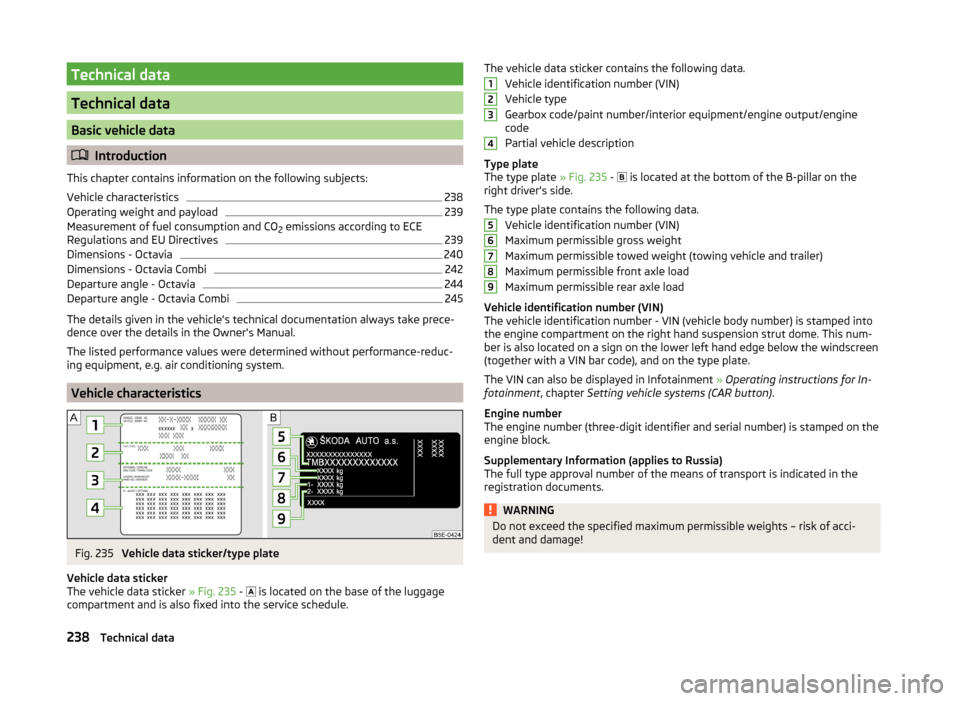
Technical data
Technical data
Basic vehicle data
Introduction
This chapter contains information on the following subjects:
Vehicle characteristics
238
Operating weight and payload
239
Measurement of fuel consumption and CO 2 emissions according to ECE
Regulations and EU Directives
239
Dimensions - Octavia
240
Dimensions - Octavia Combi
242
Departure angle - Octavia
244
Departure angle - Octavia Combi
245
The details given in the vehicle's technical documentation always take prece-
dence over the details in the Owner's Manual.
The listed performance values were determined without performance-reduc- ing equipment, e.g. air conditioning system.
Vehicle characteristics
Fig. 235
Vehicle data sticker/type plate
Vehicle data sticker
The vehicle data sticker » Fig. 235 -
is located on the base of the luggage
compartment and is also fixed into the service schedule.
The vehicle data sticker contains the following data.
Vehicle identification number (VIN)
Vehicle type
Gearbox code/paint number/interior equipment/engine output/engine
code
Partial vehicle description
Type plate
The type plate » Fig. 235 -
is located at the bottom of the B-pillar on the
right driver's side.
The type plate contains the following data. Vehicle identification number (VIN)
Maximum permissible gross weight
Maximum permissible towed weight (towing vehicle and trailer)
Maximum permissible front axle load
Maximum permissible rear axle load
Vehicle identification number (VIN)
The vehicle identification number - VIN (vehicle body number) is stamped into
the engine compartment on the right hand suspension strut dome. This num-
ber is also located on a sign on the lower left hand edge below the windscreen
(together with a VIN bar code), and on the type plate.
The VIN can also be displayed in Infotainment » Operating instructions for In-
fotainment , chapter Setting vehicle systems (CAR button) .
Engine number
The engine number (three-digit identifier and serial number) is stamped on the
engine block.
Supplementary Information (applies to Russia)
The full type approval number of the means of transport is indicated in the
registration documents.WARNINGDo not exceed the specified maximum permissible weights – risk of acci-
dent and damage!123456789238Technical data
Page 242 of 280
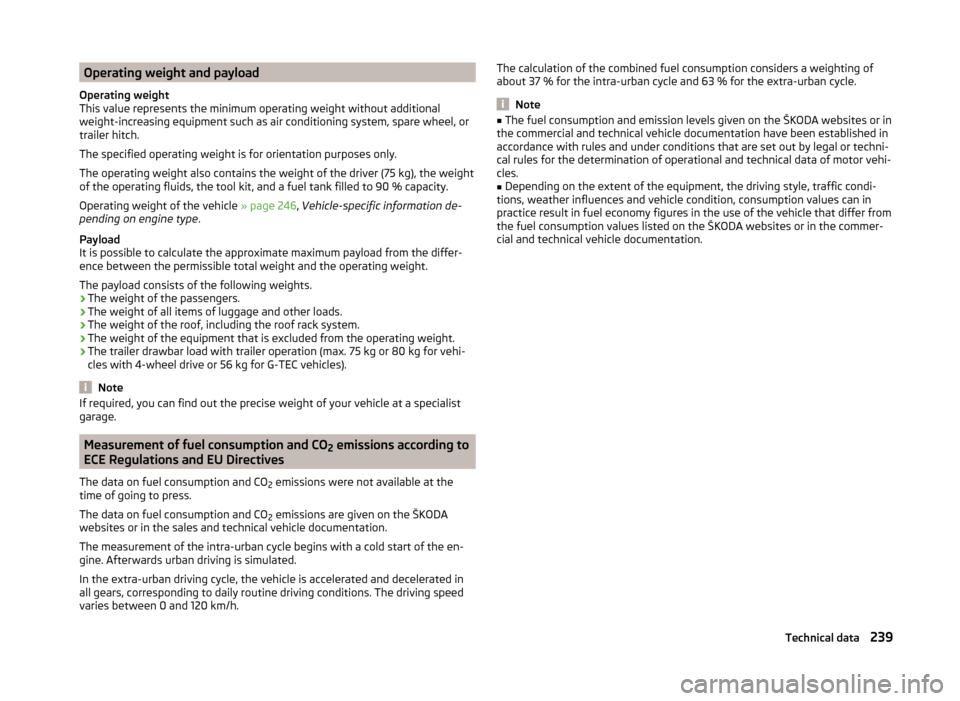
Operating weight and payload
Operating weight
This value represents the minimum operating weight without additional
weight-increasing equipment such as air conditioning system, spare wheel, or
trailer hitch.
The specified operating weight is for orientation purposes only.
The operating weight also contains the weight of the driver (75 kg), the weight
of the operating fluids, the tool kit, and a fuel tank filled to 90 % capacity.
Operating weight of the vehicle » page 246, Vehicle-specific information de-
pending on engine type .
Payload
It is possible to calculate the approximate maximum payload from the differ-
ence between the permissible total weight and the operating weight.
The payload consists of the following weights.
› The weight of the passengers.
› The weight of all items of luggage and other loads.
› The weight of the roof, including the roof rack system.
› The weight of the equipment that is excluded from the operating weight.
› The trailer drawbar load with trailer operation (max. 75 kg or 80 kg for vehi-
cles with 4-wheel drive or 56 kg for G-TEC vehicles).
Note
If required, you can find out the precise weight of your vehicle at a specialist
garage.
Measurement of fuel consumption and CO 2 emissions according to
ECE Regulations and EU Directives
The data on fuel consumption and CO 2 emissions were not available at the
time of going to press.
The data on fuel consumption and CO 2 emissions are given on the ŠKODA
websites or in the sales and technical vehicle documentation.
The measurement of the intra-urban cycle begins with a cold start of the en-
gine. Afterwards urban driving is simulated.
In the extra-urban driving cycle, the vehicle is accelerated and decelerated in
all gears, corresponding to daily routine driving conditions. The driving speed
varies between 0 and 120 km/h.
The calculation of the combined fuel consumption considers a weighting of
about 37 % for the intra-urban cycle and 63 % for the extra-urban cycle.
Note
■ The fuel consumption and emission levels given on the ŠKODA websites or in
the commercial and technical vehicle documentation have been established in
accordance with rules and under conditions that are set out by legal or techni-
cal rules for the determination of operational and technical data of motor vehi-
cles.■
Depending on the extent of the equipment, the driving style, traffic condi-
tions, weather influences and vehicle condition, consumption values can in
practice result in fuel economy figures in the use of the vehicle that differ from
the fuel consumption values listed on the ŠKODA websites or in the commer-
cial and technical vehicle documentation.
239Technical data
Page 243 of 280

Dimensions - OctaviaFig. 236
Principle sketch: Vehicle dimensions
Vehicle dimensions for operating weight without driver (in mm)
» Fig. 23 6SpecificationOctaviaOctavia 4x4Octavia RSA
Height
Basic dimension1461 a)
/1458 b)1460a)
/1459 b)1449Vehicles with off-road package.1476a)
/1474 b)1475a)
/1474 b)-Vehicles with SPORT package1446a)
/1444 b)--G-TEC vehicles1461--BFront track
» table on page 241CWidth181418141814DRear track » table on page 241EWidth including exterior mirror201720172017F
Clearance
Basic dimension140138128Vehicles with off-road package.155154-Vehicles with SPORT package125--G-TEC vehicles140-- 240Technical data
Page 244 of 280
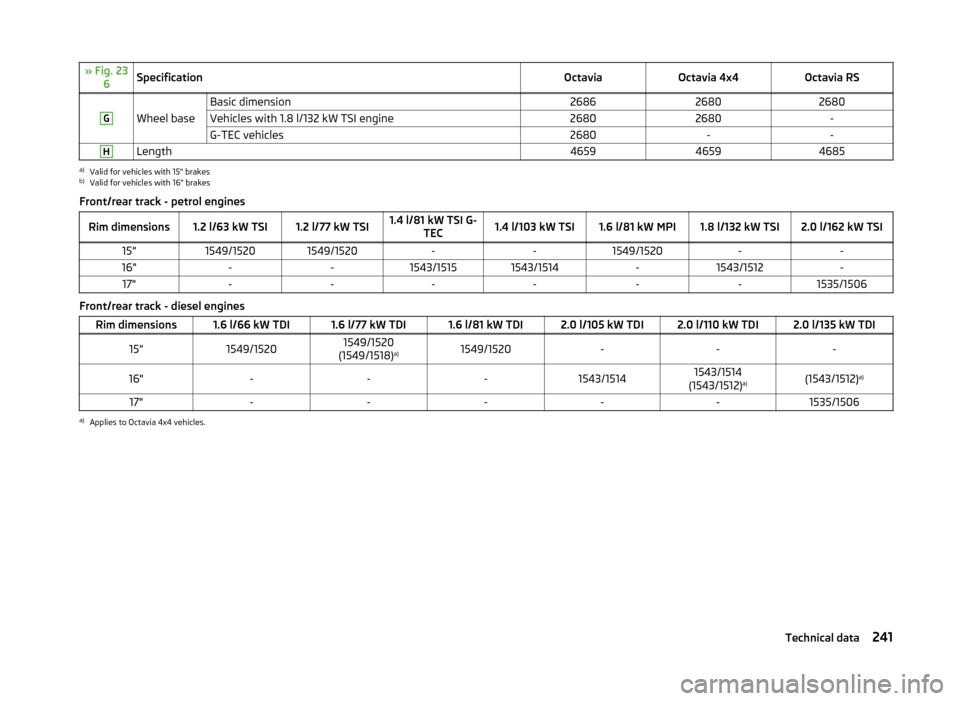
» Fig. 236SpecificationOctaviaOctavia 4x4Octavia RSG
Wheel base
Basic dimension268626802680Vehicles with 1.8 l/132 kW TSI engine26802680-G-TEC vehicles2680--HLength465946594685a)
Valid for vehicles with 15" brakes
b)
Valid for vehicles with 16" brakes
Front/rear track - petrol engines
Rim dimensions1.2 l/63 kW TSI1.2 l/77 kW TSI1.4 l/81 kW TSI G- TEC1.4 l/103 kW TSI1.6 l/81 kW MPI1.8 l/132 kW TSI2.0 l/162 kW TSI15"1549/15201549/1520--1549/1520--16"--1543/15151543/1514-1543/1512-17"------1535/1506
Front/rear track - diesel engines
Rim dimensions1.6 l/66 kW TDI1.6 l/77 kW TDI1.6 l/81 kW TDI2.0 l/105 kW TDI2.0 l/110 kW TDI2.0 l/135 kW TDI15"1549/15201549/1520
(1549/1518) a)1549/1520---16"---1543/15141543/1514
(1543/1512) a)(1543/1512)
a)17"-----1535/1506a)
Applies to Octavia 4x4 vehicles.
241Technical data
Page 245 of 280

Dimensions - Octavia CombiFig. 237
Schematic diagram: Vehicle dimensions
Vehicle dimensions for operating weight without driver (in mm)
» Fig. 237SpecificationOctavia EstateOCTAVIA Estate 4x4OCTAVIA Estate RSOCTAVIA EstateSCOUTA
Height
Basic dimension1465 a)
/1463 b)1465a)
/1463 b)14521531Vehicles with off-road package.1480a)
/1478 b)1480a)
/1478 b)--Vehicles with SPORT package1450a)
/1448 b)---G-TEC vehicles1465---BFront track
» table on page 243CWidth1814181418141814DRear track » table on page 243EWidth including exterior mirror2017201720172017F
Clearance
Basic dimension140139127171Vehicles with off-road package.155154- Vehicles with SPORT package125---G-TEC vehicles140--- 242Technical data